Effects of Nitrogen Fertilizer Management on Dry Matter Accumulation and Yield of Drip-Irrigated Sugar Beet in Arid Areas
Abstract
:1. Introduction
2. Materials and Methods
2.1. Experimental Site
2.2. Experimental Design
2.3. Leaf Area Index, Leaf Area Duration, and Leaf Senescence Rate
2.4. Fitting of Dry Matter Accumulation Dynamics
2.5. Yield and Sugar Content Determination
2.6. Data Analysis
3. Results
3.1. Dry Matter Accumulation Dynamics of Sugar Beet Shoots under Different N Fertilizer Management
3.2. Dry Matter Accumulation Dynamics of Sugar Beet Taproots under Different N Fertilizer Managements
3.3. Dynamics of DMA in the Shoots and Taproots of Sugar Beet under Different N Fertilizer Managements
3.4. Assimilate Partitioning Index of Shoots and Taproots of Sugar Beet under Different N Fertilizer Management
3.5. Leaf Growth Dynamics of Sugar Beet under Different N Fertilizer Management
3.6. Agronomic Nitrogen Use Efficiency (aNUE) in Sugar Beet at Harvest Time under Different N Fertilizer Management
3.7. Taproot Yield, Sugar Yield, and Sugar Content of Harvested Sugar Beets under Different N Fertilizer Management
3.8. Correlation between Yield, Sugar Content, and aNUE of Sugar Beet at Harvest Time, and Leaf Growth and Senescence under Different N Fertilizer Management
4. Discussion
5. Conclusions
Author Contributions
Funding
Data Availability Statement
Conflicts of Interest
References
- FAOSTAT. 2022. Available online: https://www.fao.org/faostat/zh/#data/QCL (accessed on 6 September 2022).
- National Bureau of Statistics. 2022. Available online: https://data.stats.gov.cn/easyquery.htm?cn=C01 (accessed on 18 March 2023).
- Haqshenas, A.; Azizi, K.; Ghasemi, S.; Firouzabadi, F.N.; Hosseinpour, M. N reduction and foliar application of zinc sulfate improve the physiological and biochemical characteristics of two autumn-sown sugar beet (Beta vulgaris L.). Acta Physiol. Plant. 2023, 45, 134. [Google Scholar] [CrossRef]
- Zhang, P.; Yang, F.; Zhang, H.; Liu, L.; Liu, X.; Chen, J.; Li, C. Beneficial effects of biochar-based organic fertilizer on N assimilation, antioxidant capacities, and photosynthesis of sugar beet (Beta vulgaris L.) under saline-alkaline stress. Agronomy 2020, 10, 1562. [Google Scholar] [CrossRef]
- Leilah, A.A.; Khan, N. Interactive effects of gibberellic acid and N fertilization on the growth, yield, and quality of sugar beet. Agronomy 2021, 11, 137. [Google Scholar] [CrossRef]
- Lemanski, K.; Armbruster, M.; Bonkowski, M. Linking soil microbial nutrient limitation to fertilizer regime and sugar beet yield. Plant Soil 2019, 441, 253–259. [Google Scholar] [CrossRef]
- Li, J.; Liu, X.; Xu, L.; Li, W.; Yao, Q.; Yin, X.; Wang, Q.; Tan, W.; Xing, W.; Liu, D. Low N stress-induced transcriptome changes revealed the molecular response and tolerance characteristics in maintaining the C/N balance of sugar beet (Beta vulgaris L.). Front. Plant Sci. 2023, 14, 1164151. [Google Scholar] [CrossRef] [PubMed]
- Yan, F.; Zhang, F.; Fan, J.; Hou, X.; Bai, W.; Liu, X.; Pan, X. Optimization of irrigation and N fertilization increases ash salt accumulation and ions absorption of drip-fertigated sugar beet in saline-alkali soils. Field Crop. Res. 2021, 271, 108247. [Google Scholar] [CrossRef]
- Pospišil, M.; Pospišil, A.; Rastija, M. Effect of plant density and N rates upon the leaf area of seed sugar beet on seed yield and quality. Eur. J. Agron. 2000, 12, 69–78. [Google Scholar] [CrossRef]
- Al-Dhumri, S.A.; Al Mosallam, M.S.; Zhang, W.; Alharbi, S.; Abou-Elwafa, S.F. Application of molasses as an eco-innovative approach substitutes mineral N fertilization and enhances sugar beet productivity. Waste Biomass Valorization 2023, 14, 287–296. [Google Scholar] [CrossRef]
- Tarkalson, D. Nitrogen Requirement for sugar beets: A summary of past and present research findings. In Proceedings of the Idaho Nutrient Management Conference, Jerome, ID, USA, 6 March 2012; USDA-ARS 2012/03. Volume VI, pp. 15–19. [Google Scholar]
- Hoffmann, E.C.; Christa, M. Drought tolerance of sugar beet? Evaluation of genotypic differences in yield potential and yield stability under varying environmental conditions. Eur. J. Agron. 2021, 125, 126262. [Google Scholar]
- Li, Z.; Li, G.; Sun, Y.; Su, W.; Fan, F.; Zhang, S. Effects of water and N supply on N assimilation and utilization of sugar beet (Beta vulgaris) with drip irrigation under plastic mulch. Plant Physiol. J. 2019, 55, 803–813. [Google Scholar]
- Xu, L.; Chang, X.; Zhang, Y.; Li, J.; Liu, X.; Xu, Z.; Liu, D. Effects of different N fertilizer levels on physiology, yield and quality of sugar beet. Sugar Crops China 2023, 45, 40–46. [Google Scholar]
- Chen, J.; Wang, X.; Liu, X.; Wang, S.; Zhao, J.; Zhang, H.; Li, C. Beneficial Effects of Biochar-Based Organic Fertilizers on N Assimilation, Photosynthesis, and Sucrose Synthesis of Sugar Beet (Beta vulgaris L.). Int. J. Plant Prod. 2022, 16, 755–768. [Google Scholar] [CrossRef]
- Varga, I.; Radočaj, D.; Jurišić, M.; Kulundžić, A.M.; Antunović, M. Prediction of sugar beet yield and quality parameters with varying N fertilization using ensemble decision trees and artificial neural networks. Comput. Electron. Agr. 2023, 212, 108076. [Google Scholar] [CrossRef]
- Ma, F.Y.; Liu, Y.; Cui, J.; Fan, H.; Lu, Y.; Li, M.R. Review on the research progress of water and fertilizer integration. Xinjiang Agric. Sci. 2019, 56, 183–192. [Google Scholar]
- Wang, J.; Bai, R.X.; Chen, Y.H.; Wei, C.Z.; Yang, K.M.; Cui, J. Effect of N application on dry matter, N accumulation, yield and quality of sugar beet in Ta’s Basin. Acta Agric. Boreali-Occident. Sin. 2021, 30, 234–242. [Google Scholar]
- Fei, C.; Su, J.X.; Li, Y.Y.; Li, Z.F.; Wang, K.Y.; Fan, H.; Ma, F.Y. Light-response characteristics of photosynthesis of drip-irrigated sugar beet under different N fertilizer managements. Photosynthetica 2019, 57, 804–811. [Google Scholar] [CrossRef]
- Zhou, H.; Xu, P.; Zhang, L.; Huang, R.; Zhang, C.; Xiang, D.; Fan, H. Effects of regulated deficit irrigation combined with optimize N fertilizer management on resource use efficiency and yield of sugar beet in arid regions. J. Clean. Prod. 2022, 380, 134874. [Google Scholar] [CrossRef]
- Bao, S.D. Soil Agrochemical Analysis; China Agricultural Publishing House: Beijing, China, 2013. [Google Scholar]
- Ren, B.; Zhang, J.; Dong, S.; Zhao, H.; Liu, P. Effect of Water logging at Early Period on Canopy Structure and Photosynthetic Characteristics of Summer Maize. Sci. Agric. Sin. 2017, 50, 11. [Google Scholar]
- Mao, L.; Zhang, L.; Sun, X.; van der Werf, W.; Evers, J.B.; Zhao, X.; Li, Z. Use of the beta growth function to quantitatively characterize the effects of plant density and a growth regulator on growth and biomass partitioning in cotton. Field Crop. Res. 2018, 224, 28–36. [Google Scholar] [CrossRef]
- Chen, Y.; Zhang, Z.; Wang, X.; Sun, S.; Zhang, Y.; Wang, S.; Zhang, L. Sap velocity, transpiration and water use efficiency of drip-irrigated cotton in response to chemical topping and row spacing. Agric. Water Manag. 2022, 267, 107611. [Google Scholar] [CrossRef]
- Wan, X.J.; Wu, W.; Shah, F. N fertilizer management for mitigating ammonia emission and increasing N use efficiencies by 15N stable isotopes in winter wheat. Sci. Total Environ. 2021, 790, 147587. [Google Scholar] [CrossRef] [PubMed]
- Yan, F.; Liu, X.; Bai, W.; Fan, J.; Zhang, F.; Xiang, Y.; Wang, Y. Multi-objective optimization of water and nitrogen regimes for drip-fertigated sugar beet in a desert climate. Field Crops Res. 2022, 288, 108703. [Google Scholar] [CrossRef]
- Monreal, J.A.; Jimenez, E.T.; Remesal, E.; Morillo-Velarde, R.; García-Mauriño, S.; Echevarría, C. Proline content of sugar beet storage roots: Response to water deficit and N fertilization at field conditions. Environ. Exp. Bot. 2007, 60, 257–267. [Google Scholar] [CrossRef]
- Zhou, H.; Wang, L.; Xu, P.; Zhang, L.; Huang, R.; Yang, M.; Fan, H. Deficit irrigation combined with N application in the early growth stage of sugar beet increases the production capacity of canopy and avoids yield loss. J. Sci. Food Agric. 2023, 103, 7600–7611. [Google Scholar] [CrossRef] [PubMed]
- Schnepel, K.; Hoffmann, C.M. Effect of extending the growing period on yield formation of sugar beet. J. Agron. Crop Sci. 2016, 202, 530–541. [Google Scholar] [CrossRef]
- Kiymaz, S.; Ertek, A. Yield and quality of sugar beet (Beta vulgaris L.) at different water and N levels under the climatic conditions of Kırsehir, Turkey. Agric. Water Manag. 2015, 158, 156–165. [Google Scholar] [CrossRef]
- Żarski, J.; Kuśmierek-Tomaszewska, R.; Dudek, S. Impact of irrigation and fertigation on the yield and quality of sugar beet (Beta vulgaris L.) in a moderate climate. Agronomy 2020, 10, 166. [Google Scholar] [CrossRef]
- Liu, Z.H.; Bo, L.J.; Li, Y.; Sun, M.; Zhong, Z.W.; Zhang, Y.P.; Jing, Y.P. Effect of N fertilizer reduction on crop yield and ecological environment: A review. Soil Fertil. Sci. China 2016, 4, 1–8. [Google Scholar]
- Zhang, P.F.; Zhang, Y.F.; Wang, Y.F.; Zhang, W.C.; Chen, T.Y.; Pang, C.; Wu, Q.; Wang, H.P.; Wu, P.; Yin, X.W.; et al. Effects of N topdressing amount at various stages on N efficiency of maize and soil N balance under mulched drip irrigation. J. Plant Nutr. Fertil. 2018, 24, 915–926. [Google Scholar]
- Wu, B.; Yang, P.; Zuo, W.; Zhang, W. Optimizing water and N management can enhance N heterogeneity and stimulate root foraging. Field Crops Res. 2023, 304, 109183. [Google Scholar] [CrossRef]
- Vamerali, T.; Guarise, M.; Ganis, A.; Mosca, G. Effects of water and N management on fibrous root distribution and turnover in sugar beet. Eur. J. Agron. 2009, 31, 69–76. [Google Scholar] [CrossRef]
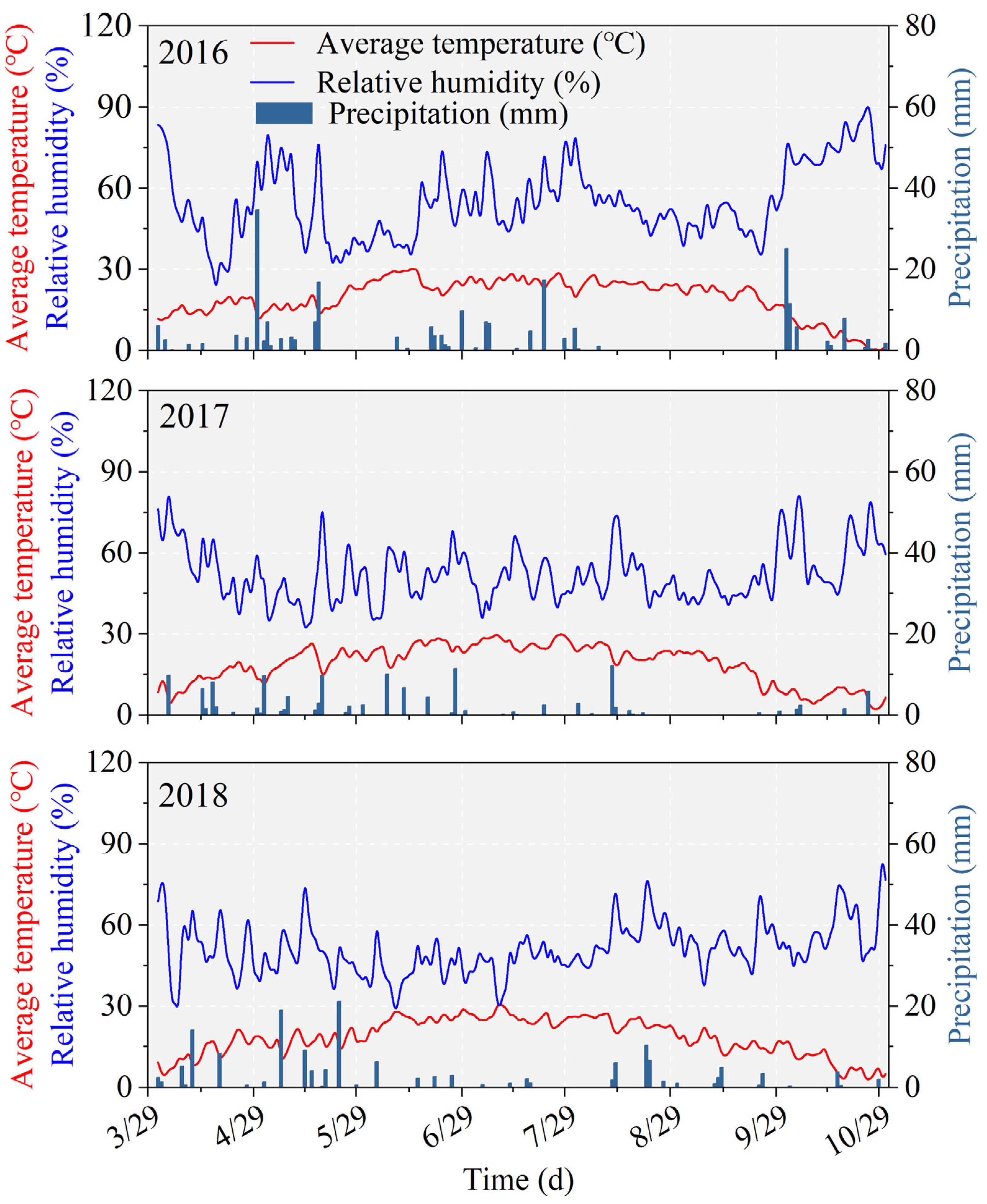
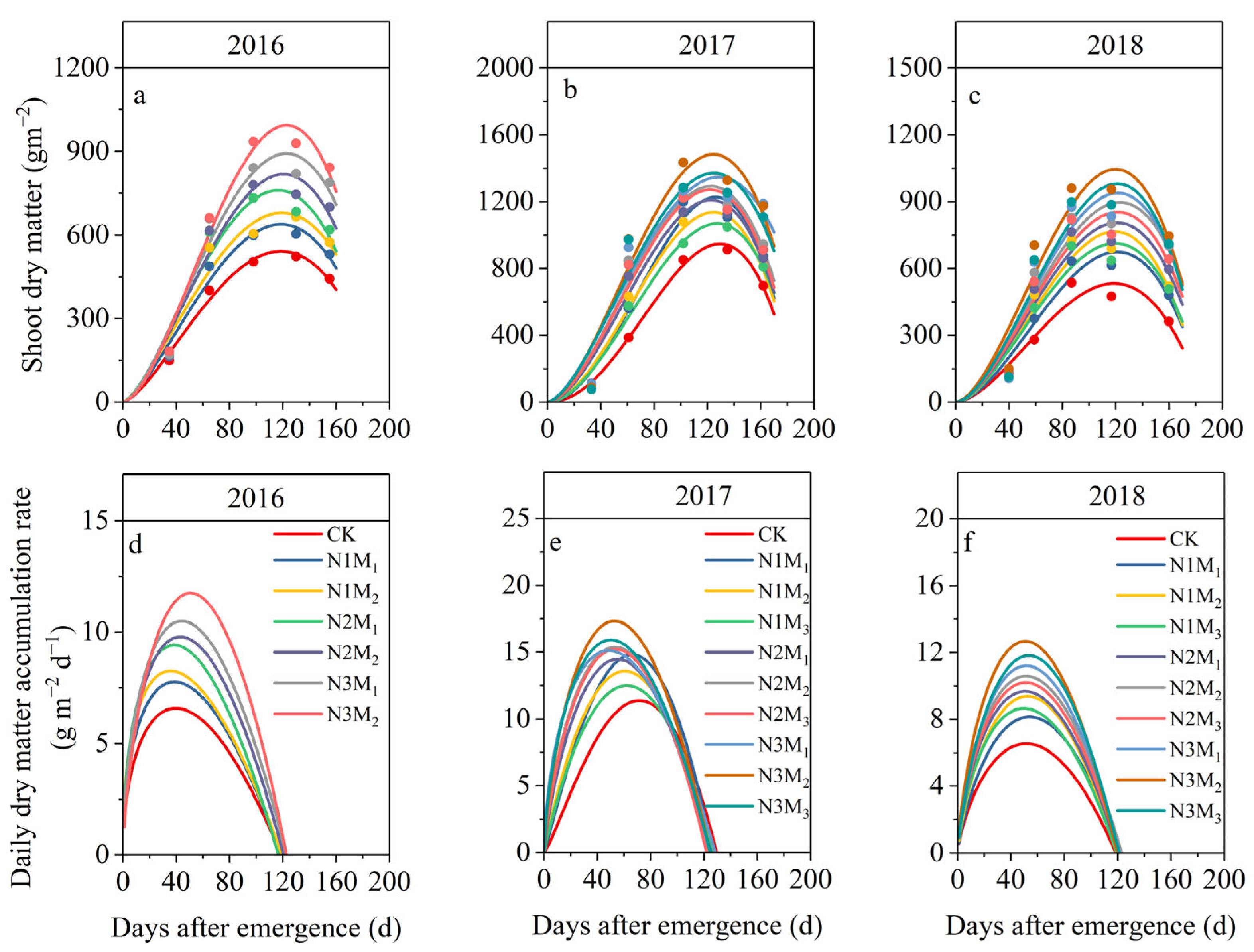
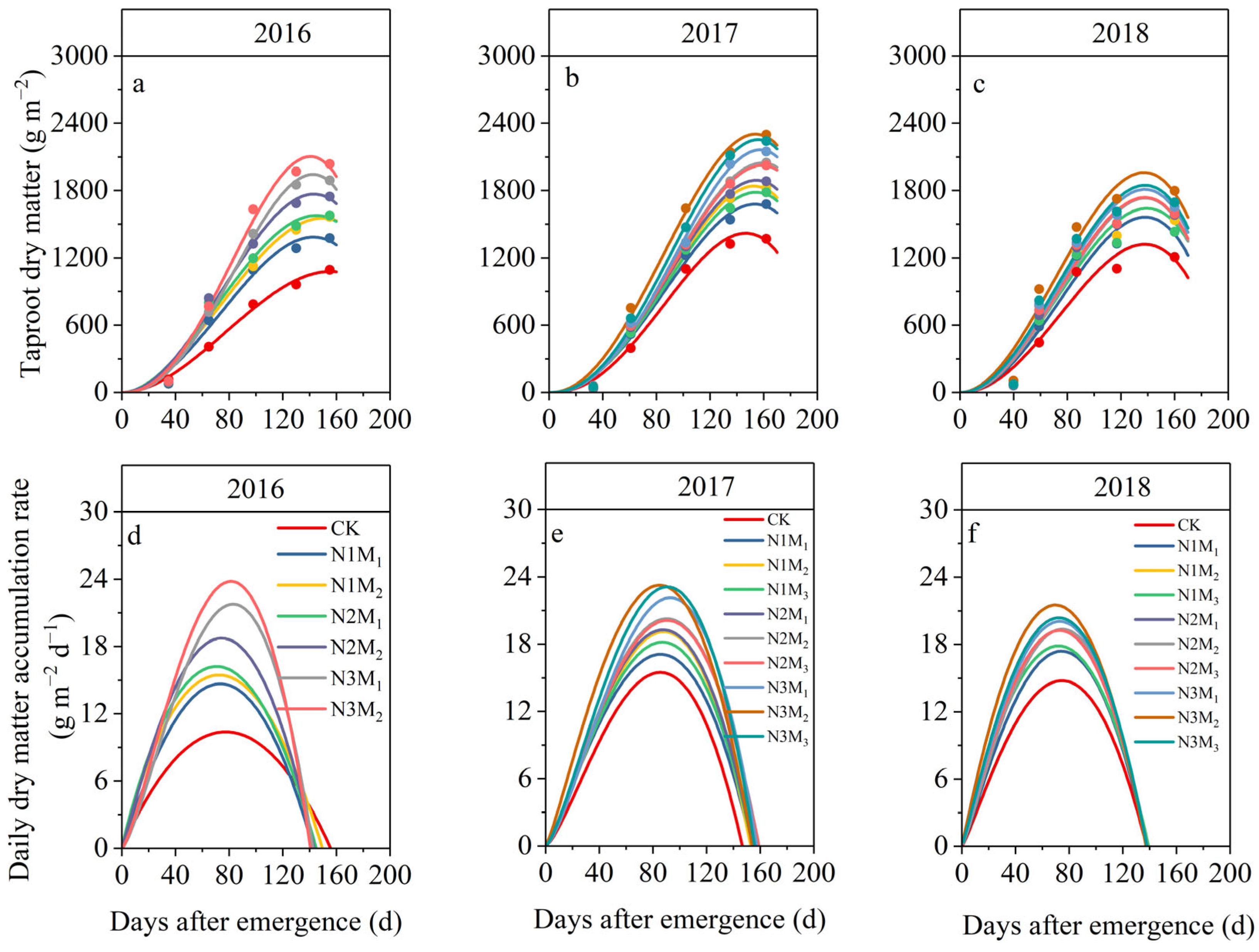
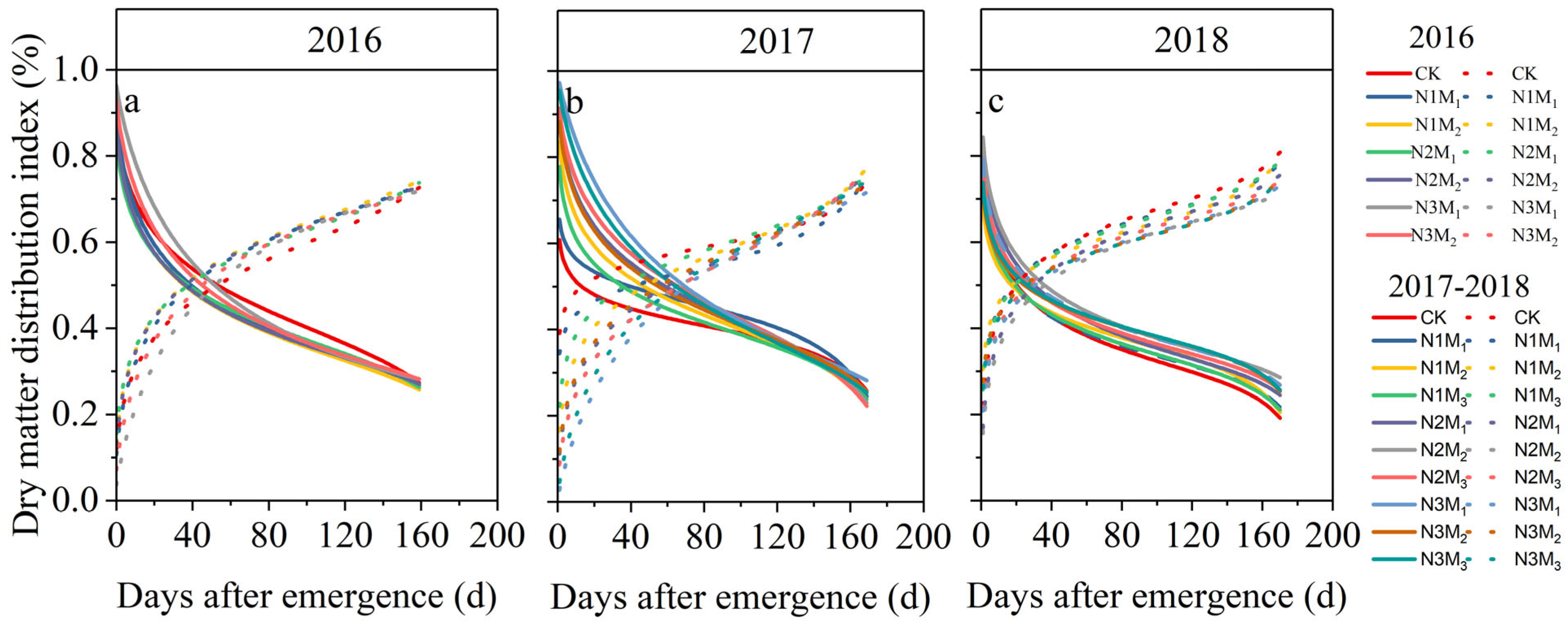
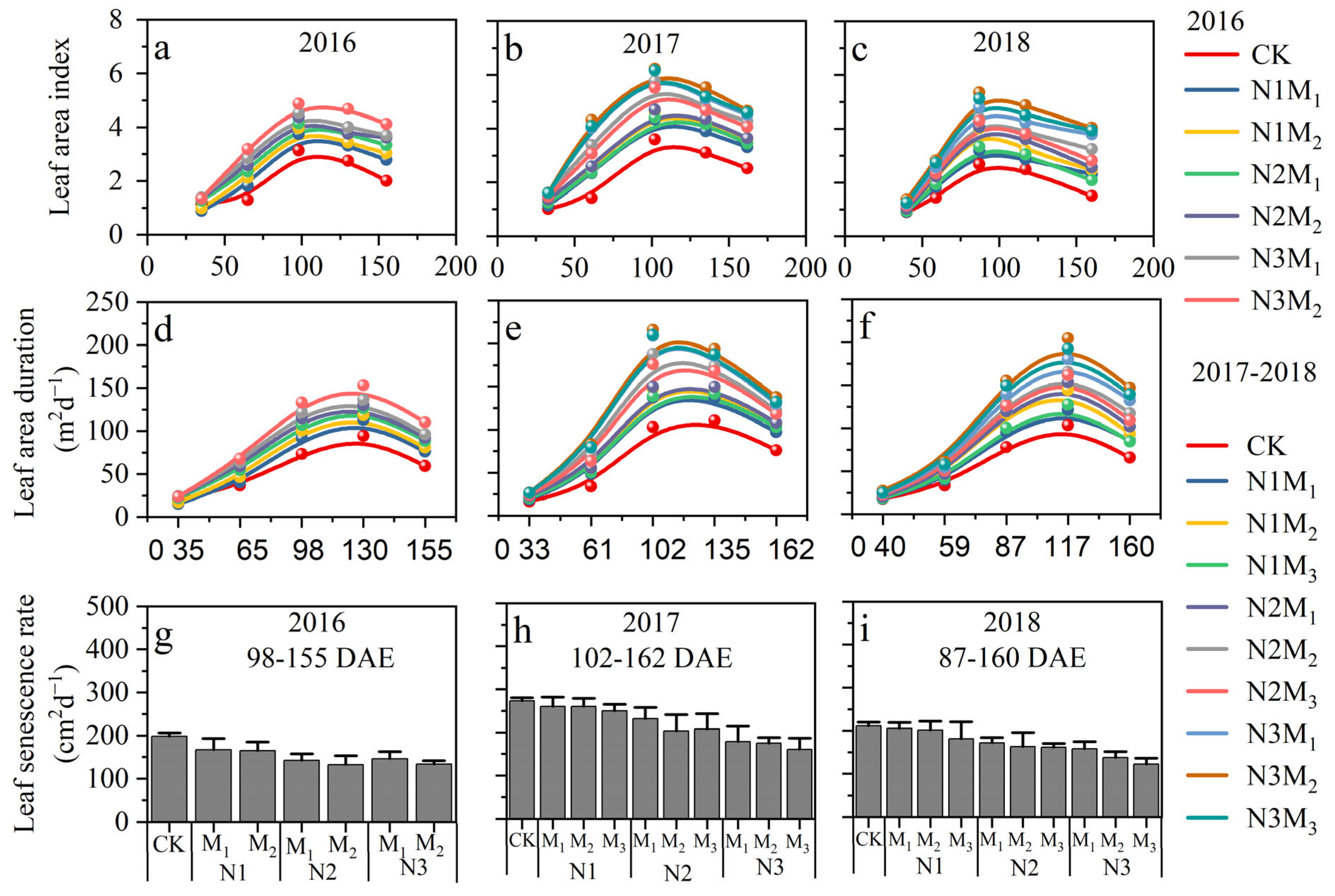


| Year | pH (1:2.5) | Organic Matter Content (g kg−1) | Total Nitrogen Content (g kg−1) | Olsen-P (mg kg−1) | Available Potassium Content (mg kg−1) | Bulk Density (g cm−3) | Field Capacity (%) |
|---|---|---|---|---|---|---|---|
| 2016 | 7.30 ± 0.02 | 13.27 ± 0.22 | 0.76 ± 0.03 | 22.56 ± 0.12 | 157.97 ± 1.47 | 1.45 ± 0.12 | 19.00 ± 0.59 |
| 2017 | 7.30 ± 0.01 | 13.25 ± 0.18 | 0.88 ± 0.05 | 22.60 ± 0.20 | 157.97 ± 2.17 | 1.52 ± 0.08 | 20.00 ± 0.85 |
| 2018 | 7.30 ± 0.03 | 13.24 ± 0.31 | 0.78 ± 0.01 | 22.47 ± 0.19 | 156.17 ± 2.98 | 1.48 ± 0.19 | 19.80 ± 0.34 |
| Stage | Canopy Rapid Growth Stage | Taproot Expansion Stage | Sugar Accumulation Stage | ||
|---|---|---|---|---|---|
| Date | 4 June 2016 | 13 June 2016 | 1 July 2016 | 1 August 2016 | |
| CK | 0 | 0 | / | ||
| N1 | M1 | 37.50 | 37.50 | 0 | / |
| M2 | 26.25 | 26.25 | 22.50 | / | |
| N2 | M1 | 75.00 | 75.00 | 0 | / |
| M2 | 52.50 | 52.50 | 45.00 | / | |
| N3 | M1 | 112.50 | 112.50 | 0 | / |
| M2 | 78.75 | 78.75 | 67.50 | / | |
| Date | 14 June 2017 | 25 June 2017 | 25 July 2017 | 25 August 2017 | |
| CK | 0 | 0 | 0 | ||
| M1 | 37.50 | 37.50 | 0 | 0 | |
| N1 | M2 | 26.25 | 26.25 | 22.50 | 0 |
| M3 | 18.75 | 18.75 | 22.50 | 15.00 | |
| M1 | 75.00 | 75.00 | 0 | 0 | |
| N2 | M2 | 52.50 | 52.50 | 45.00 | 0 |
| M3 | 37.50 | 37.50 | 45.00 | 30.00 | |
| M1 | 112.50 | 112.50 | 0 | 0 | |
| N3 | M2 | 78.75 | 78.75 | 67.50 | 0 |
| M3 | 56.25 | 56.25 | 67.50 | 45.00 | |
| Date | 17 June 2018 | 28 June 2018 | 21 July 2018 | 25 August 2018 | |
| CK | 0 | 0 | 0 | ||
| M1 | 37.50 | 37.50 | 0 | 0 | |
| N1 | M2 | 26.25 | 26.25 | 22.50 | 0 |
| M3 | 18.75 | 18.75 | 22.50 | 15.00 | |
| M1 | 75.00 | 75.00 | 0 | 0 | |
| N2 | M2 | 52.50 | 52.50 | 45.00 | 0 |
| M3 | 37.50 | 37.50 | 45.00 | 30.00 | |
| M1 | 112.50 | 112.50 | 0 | 0 | |
| N3 | M2 | 78.75 | 78.75 | 67.50 | 0 |
| M3 | 56.25 | 56.25 | 67.50 | 45.00 | |
| Year | Treatment | Shoot | Taproot | ||||||
|---|---|---|---|---|---|---|---|---|---|
| Wmax (g/m2) | te (d) | tm (d) | Cm (g/m2 d) | Wmax (g/m2) | te (d) | tm (d) | Cm (g/m2 d) | ||
| 2016 | CK | 541.6 d | 118.7 b | 39.7 bc | 6.6 c | 1078.8 c | 155.7 a | 77.5 b | 10.4 d |
| N1M1 | 638.4 cd | 118.7 b | 38.7 bc | 7.8 bc | 1384.4 b | 142.8 b | 73.3 bc | 14.7 c | |
| N1M2 | 680 c | 119.3 ab | 35.9 c | 8.3 b | 1553.4 ab | 149.6 b | 72.5 c | 15.5 bc | |
| N2M1 | 760.6 bc | 116.6 b | 38.6 bc | 9.4 ab | 1577 ab | 144.9 b | 70.6 c | 16.2 b | |
| N2M2 | 818.3 b | 120.6 a | 43.1 b | 9.8 ab | 1414.9 b | 143.2 b | 74.3 bc | 15.0 bc | |
| N3M1 | 893.1 ab | 122.7 a | 44.3 b | 10.5 a | 1554.4 ab | 142.5 b | 82.9 a | 17.4 ab | |
| N3M2 | 994.2 a | 122.8 a | 50.7 a | 11.8 a | 1682.8 a | 140.7 b | 81.4 a | 19.0 a | |
| 2017 | CK | 947.7 c | 129.5 a | 71.4 a | 11.4 c | 1419.3 e | 146.6 d | 85.5 c | 15.4 e |
| N1M1 | 1226.5 b | 126.2 a | 66.2 ab | 14.8 b | 1678.9 d | 153.5 bc | 85.7 bc | 17.1 d | |
| N1M2 | 1136.4 bc | 124.6 a | 60.7 b | 13.6 bc | 1839.8 c | 152.8 c | 88.0 b | 19.1 c | |
| N1M3 | 1068.8 bc | 127.5 a | 62.2 b | 12.5 c | 1785.1 cd | 154.3 b | 87.1 b | 18.2 cd | |
| N2M1 | 1209.8 b | 122.7 a | 55.2 c | 14.5 b | 1891.3 c | 154.5 b | 87.6 b | 19.3 bc | |
| N2M2 | 1291.6 b | 122.6 | 53.3 c | 15.4 ab | 2046.8 b | 159.1 a | 90.3 ab | 20.2 b | |
| N2M3 | 1271.0 b | 122.0 a | 53.6 c | 15.2 ab | 2023.2 bc | 158.7 a | 90.6 ab | 20.2 b | |
| N3M1 | 1346.2 ab | 128.6 a | 48.6 d | 15.1 ab | 2163.1 b | 157.4 a | 93.0 a | 22.2 ab | |
| N3M2 | 1483.5 a | 124.6 a | 52.9 c | 17.3 a | 2303.3 a | 153.9 b | 85.0 c | 23.3 a | |
| N3M3 | 1370.6 ab | 124.8 a | 50.2 cd | 15.9 ab | 2253.8 ab | 155.8 ab | 90.7 ab | 23.1 a | |
| 2018 | CK | 533.0 d | 118.9 b | 51.5 ab | 6.5 d | 1320.9 d | 137.7 a | 74.6 a | 14.8 c |
| N1M1 | 674.1 c | 121.1 a | 54.0 a | 8.1 c | 1562.1 c | 138.0 a | 74.3 a | 17.4 b | |
| N1M2 | 765.3 bc | 119.3 b | 52.5 a | 9.4 b | 1641.8 bc | 139.2 a | 72.0 a | 17.9 b | |
| N1M3 | 712.8 c | 119.5 b | 49.8 b | 8.7 bc | 1641.8 bc | 139.2 a | 72.0 a | 17.9 b | |
| N2M1 | 805.1 b | 120.9 ab | 50.6 b | 9.7 b | 1733.1 b | 138.1 a | 74.9 a | 19.4 ab | |
| N2M2 | 896.9 ab | 123.1 a | 51.4 ab | 10.6 ab | 1733.6 b | 138.1 | 74.9 a | 19.4 ab | |
| N2M3 | 852.9 | 121.5 a | 51.2 ab | 10.2 ab | 1738.7 b | 137.8 | 72.8 a | 19.3 ab | |
| N3M1 | 938.1 a | 121.7 a | 51.7 ab | 11.2 a | 1810.3 ab | 137.9 a | 73.0 a | 20.1 a | |
| N3M2 | 1045.0 a | 120.0 ab | 50.8 b | 12.7 a | 1960.1 a | 137.3 a | 69.7 b | 21.5 a | |
| N3M3 | 979.9 a | 121.3 a | 53.4 a | 11.8 a | 1846.7 ab | 137.9 a | 72.3 a | 20.4 a | |
| Year | Treatment | Sugar Content (%) | Taproot Yield (t/ha) | Sugar Yield (t/ha) |
|---|---|---|---|---|
| 2016 | CK | 16.9 ± 2.0 a | 59.2 ± 4.1 f | 10.0 ± 0.7 b |
| N1M1 | 16 ± 1.0 ab | 70.1 ± 3.6 e | 11.2 ± 0.6 b | |
| N1M2 | 14.6 ± 0.2 bc | 76.2 ± 4.0 d | 11.1 ± 0.6 b | |
| N2M1 | 16.0 ± 0.8 ab | 85.6 ± 1.0 c | 13.7 ± 0.2 ab | |
| N2M2 | 16.5 ± 1.1 ab | 92.5 ± 4.2 b | 15.3 ± 0.7 a | |
| N3M1 | 12.8 ± 1.0 c | 94.3 ± 3.1 ab | 12.1 ± 0.4 b | |
| N3M2 | 13.8 ± 0.5 c | 99.5 ± 2.1 a | 13.7 ± 0.3 ab | |
| F value | N | 9.92 ** | 143.38 ** | 78.43 ** |
| M | 0.01 ns | 10.36 ** | 12.36 ** | |
| N*M | 0.95 ns | 1.21 ns | 4.68 * | |
| 2017 | CK | 17.1 ± 1.1 abc | 65.9 ± 2.5 d | 11.3 ± 0.4 f |
| N1M1 | 16.3 ± 0.7 abc | 77.9 ± 5.9 cd | 12.7 ± 1.1 ef | |
| N1M2 | 17.5 ± 0.5 a | 80.9 ± 2.5 c | 14.2 ± 0.4 de | |
| N1M3 | 14.4 ± 0.3d | 78.2 ± 3.7 cd | 11.3 ± 0.5 f | |
| N2M1 | 16.4 ± 0.4 abc | 109.0 ± 12.2 ab | 17.9 ± 2 ab | |
| N2M2 | 17.3 ± 1.7 ab | 114.5 ± 2.6 a | 19.8 ± 0.4 a | |
| N2M3 | 15.3 ± 1.2 cd | 108.3 ± 6.2 ab | 16.6 ± 0.9 bc | |
| N3M1 | 16.0 ± 1.4 abcd | 102.6 ± 2.9 ab | 16.4 ± 0.5 bc | |
| N3M2 | 16.5 ± 0.3 abc | 103.1 ± 12.3 ab | 17.0 ± 2.1 bc | |
| N3M3 | 15.6 ± 1.1 bcd | 96.6 ± 10.7 b | 15.1 ± 1.7 cd | |
| F value | N | 1.99 ns | 82.58 ** | 74.61 ** |
| M | 6.62 ** | 1.01 ns | 10.62 ** | |
| N*M | 1.31 ns | 0.28 ns | 1.42 ns | |
| 2018 | CK | 15.9 ± 0.7 b | 60.7 ± 4.4 d | 9.6 ± 0.7 e |
| N1M1 | 16.2 ± 0.8 ab | 71.4 ± 3.6 c | 11.6 ± 0.6 d | |
| N1M2 | 14.2 ± 1.1 b | 72.6 ± 2.2 c | 10.3 ± 0.3 de | |
| N1M3 | 15.1 ± 1.3 b | 68.6 ± 4.7 cd | 10.4 ± 0.7 de | |
| N2M1 | 15.4 ± 1.1 b | 90.5 ± 7.3 b | 13.9 ± 1.1 bc | |
| N2M2 | 16.8 ± 1.3 a | 98.5 ± 6.1 ab | 16.5 ± 1.0 a | |
| N2M3 | 14.2 ± 0.9 b | 92.4 ± 8.1 b | 13.1 ± 1.1 c | |
| N3M1 | 14.5 ± 0.8 b | 96.3 ± 6.8 ab | 14.0 ± 1.2 bc | |
| N3M2 | 15.2 ± 0.2 b | 100.0 ± 5.3 a | 15.2 ± 0.8 ab | |
| N3M3 | 16.0 ± 0.2 ab | 94.4 ± 2.0 b | 15.1 ± 0.3 ab | |
| F value | N | 1.27 ns | 101.49 ** | 95.22 ** |
| M | 0.27 ns | 1.94 ns | 3.84 * | |
| N*M | 4.04 ** | 0.44 ns | 5.22 ** |
Disclaimer/Publisher’s Note: The statements, opinions and data contained in all publications are solely those of the individual author(s) and contributor(s) and not of MDPI and/or the editor(s). MDPI and/or the editor(s) disclaim responsibility for any injury to people or property resulting from any ideas, methods, instructions or products referred to in the content. |
© 2024 by the authors. Licensee MDPI, Basel, Switzerland. This article is an open access article distributed under the terms and conditions of the Creative Commons Attribution (CC BY) license (https://creativecommons.org/licenses/by/4.0/).
Share and Cite
Su, J.; Zhou, H.; Wang, K.; Fan, H.; Hou, Z. Effects of Nitrogen Fertilizer Management on Dry Matter Accumulation and Yield of Drip-Irrigated Sugar Beet in Arid Areas. Agronomy 2024, 14, 1010. https://doi.org/10.3390/agronomy14051010
Su J, Zhou H, Wang K, Fan H, Hou Z. Effects of Nitrogen Fertilizer Management on Dry Matter Accumulation and Yield of Drip-Irrigated Sugar Beet in Arid Areas. Agronomy. 2024; 14(5):1010. https://doi.org/10.3390/agronomy14051010
Chicago/Turabian StyleSu, Jixia, Hongliang Zhou, Kaiyong Wang, Hua Fan, and Zhenan Hou. 2024. "Effects of Nitrogen Fertilizer Management on Dry Matter Accumulation and Yield of Drip-Irrigated Sugar Beet in Arid Areas" Agronomy 14, no. 5: 1010. https://doi.org/10.3390/agronomy14051010
APA StyleSu, J., Zhou, H., Wang, K., Fan, H., & Hou, Z. (2024). Effects of Nitrogen Fertilizer Management on Dry Matter Accumulation and Yield of Drip-Irrigated Sugar Beet in Arid Areas. Agronomy, 14(5), 1010. https://doi.org/10.3390/agronomy14051010






